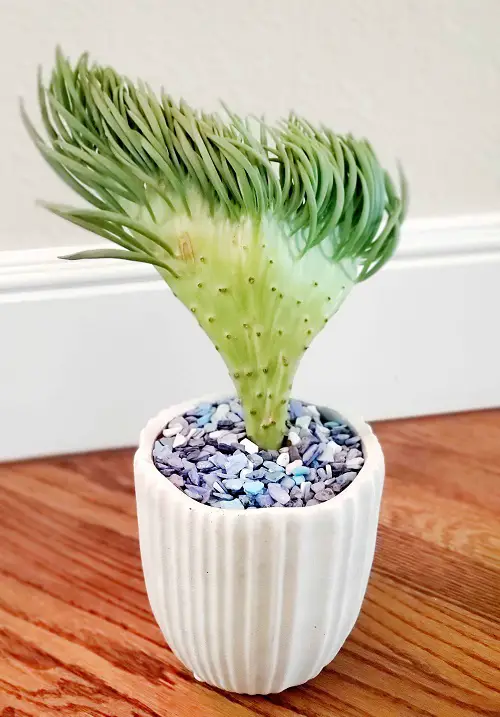Mermaid Tail Succulent is a stunning little specimen that stands out with its weird yet interesting foliage! Here’s how to grow it!

Are you willing to give your garden a unique and dramatic touch? Well, we have a plant that is somewhat similar to a mermaid’s tail. Mermaid Tail Succulent can be one of the most beautiful and easy-to-care plants for your space.
Read about Sedum Nussbaumerianum Care
Mermaid Tail Succulent Plant Information
The Mermaid Tail Succulent is also known as the String of Dolphins. This succulent plant is native to South Africa. It produces long, thin stems with small, curved leaves that resemble jumping dolphins or mermaid tails, hence its name.
The leaves are green in color with a slight blue tint. It has a distinctive shape that makes it a popular houseplant. It is a relatively easy plant to care for and can be propagated by stem cuttings.
Botanical Name: Senecio vitalis ‘Crested’
USDA Zone: 10a -11b
Mermaid Tail Succulent Pot Requirement
A suitable pot size for a young Mermaid Tail Succulent plant could be around 8-10 inches in diameter, which will be good for 2-3 years. Depending on the growth and spread, you can re-pot it into a bigger container than the old one.
Propagating Mermaid Tail Succulent Plant
The best way to propagate is by stem cuttings. To do this, simply snip off a stem with a few leaves and place it in a light, well-draining soil mix. Keep the soil moist, and in a few weeks, you should see new roots and shoots.
Requirements for Growing Mermaid Tail Succulent
Sunlight
It can tolerate full sun to partial shade, but for optimal health and growth, it needs at least 4-6 hours of direct sunlight per day.
Keep the plant safe from prolonged exposure to harsh afternoon sunlight.
Soil
Use light and airy soil with a mix of coarse sand, potting soil, and decomposed granite or pumice. A good soil mix for a mermaid tail succulent should contain one part coarse sand, one part potting soil, and one part decomposed granite or pumice.
Water
These plants are drought-tolerant and require very little water to survive. Water the plant when the soil is dry to the touch but not completely dry. Allow the soil to dry out completely between waterings. Also, Water the soil around the plant, not the foliage.
Temperature & Humidity
Mermaid tail succulent plants do best in warm, dry climates with temperatures ranging from 65-75°F (18-24°C). The ideal humidity for this plant is between 40-50%.
Discover Succulents That Look Like Peas
Mermaid Tail Succulent Care

Fertilizer
These plants need fertilizers with low nitrogen, high phosphorus, and low potassium. For the best results, look for a 0-10-10 or 5-10-10 blend.
It is best to use liquid fertilizer, after diluting it to 1/4 of its strength, once in 6-8 weeks. Also, make sure to water your plants before and after applying the fertilizer to help the fertilizer absorb into the soil. Avoid fertilizing during the winter months.
Pests and Diseases
The mermaid tail succulent is relatively pest—and disease-resistant, but it can be susceptible to mealybugs, spider mites, and scale insects. An insecticidal soap solution can get rid of them.
To keep most of the diseases at bay, avoid overwatering the plant and ensure it gets plenty of air circulation.




